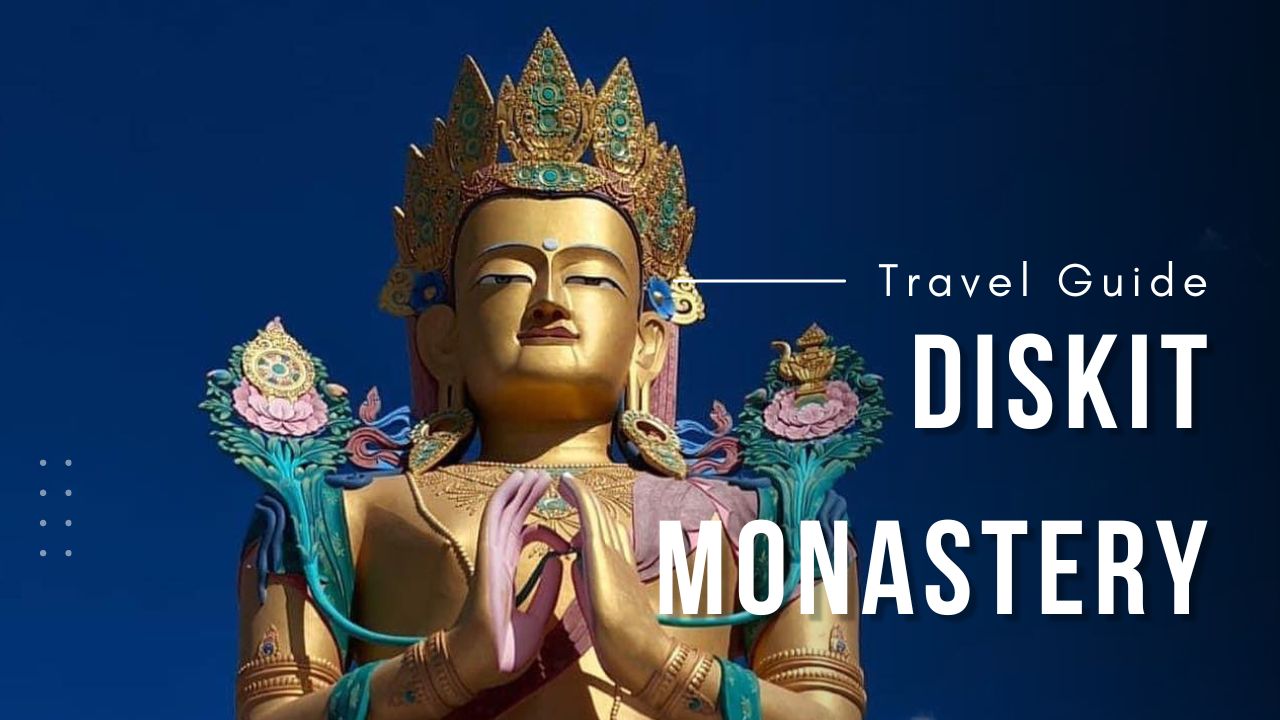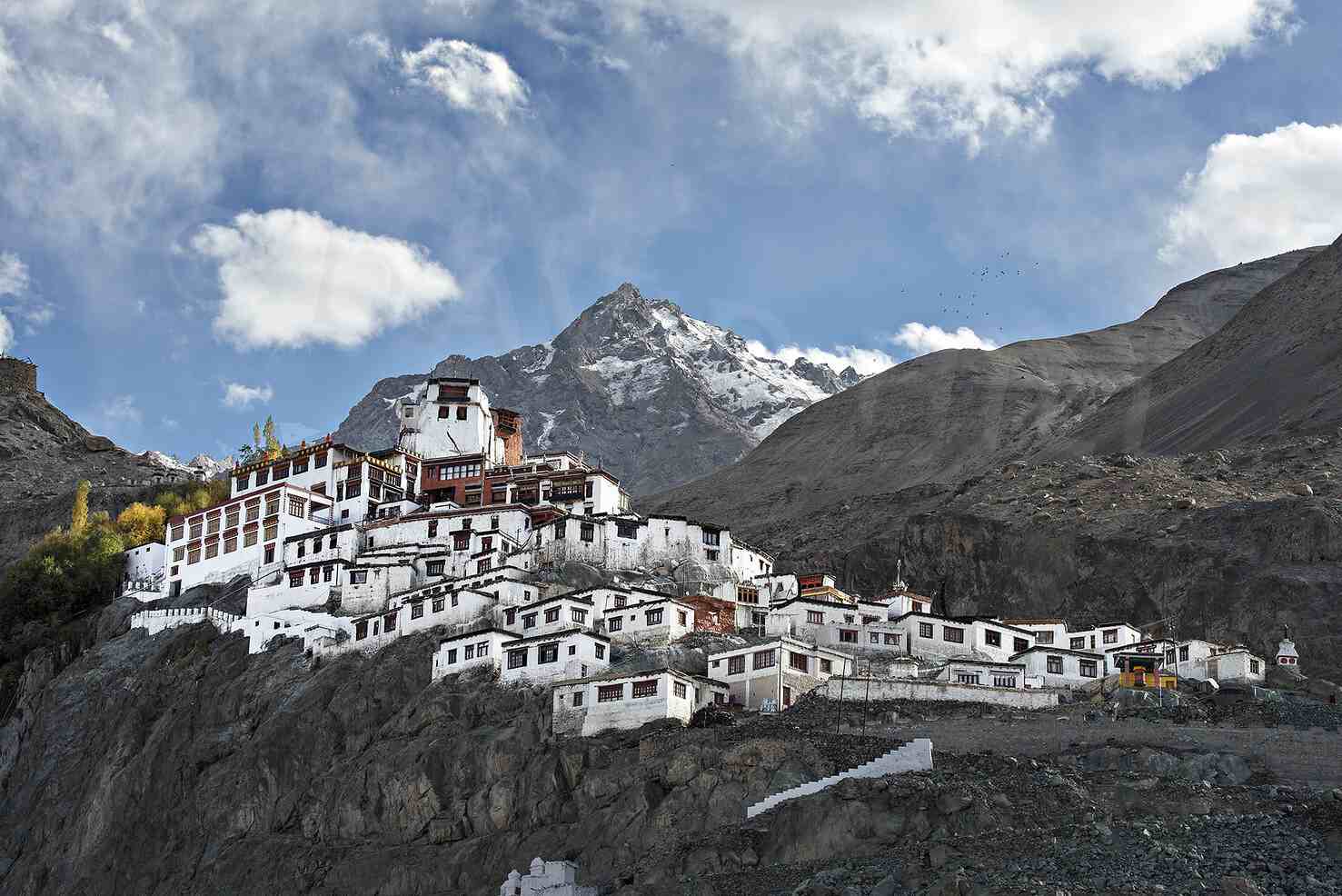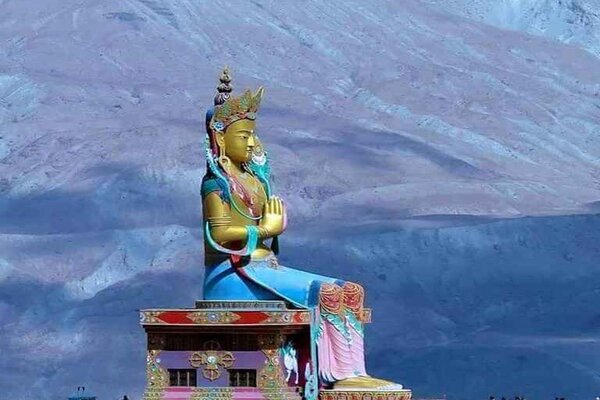
Diskit Monastery (Diskit Gompa) in Ladakh’s beautiful Nubra Valley, is a great example of the region’s spiritual and cultural history. This old Buddhist sanctuary was built in the 14th century and draws attention with its peaceful beauty and historical importance. It is atop a hillock with a wide view of the Himalayan scenery. This makes it a must-see place for travellers looking for peace and wisdom.
The huge 32-meter statue of Maitreya Buddha, who represents future enlightenment, is one of the most striking things about the temple. This amazing figure can be seen from miles away, and people come worldwide to see it. Is Diskit Monastery an important religious site and a starting point for visiting the beautiful Nubra Valley, with its lush green valleys, high mountain passes, and double-humped Bactrian camels. The Gompa offers a unique experience that speaks to the soul, whether looking for spiritual peace or an adventure into the heart of Ladakh’s natural beauty.
In addition to its spiritual atmosphere, the monastery is attractive because of its old Tibetan architecture, which is made up of painted walls and traditional designs. Visitors can take in the peaceful atmosphere and watch the monks pray, spin prayer wheels, and follow ancient practices. Diskit Monastery is a cultural and spiritual landmark in Ladakh. It invites everyone visiting to learn about the deep beauty and history that live within its holy walls.
The Diskit Monastery, also known as the Diskit Gompa, symbolises the spiritual and cultural history of the Nubra Valley in Ladakh, India. It has been around since the 14th century, making it one of the area’s oldest and most important monasteries.
Changzem Tserab Zangpo, a student of Tsongkhapa, the great Tibetan scholar and founder of the Gelugpa school of Tibetan Buddhism, is thought to have built Diskit Monastery. The monastery was set up as a place for spiritual practice, study, and enlightenment with his help.
The 32-meter-tall statue of Maitreya Buddha, built in 2010, is the Monastery’s highlight. This statue, which stands for future knowledge, brings in pilgrims and tourists because of its size and spiritual meaning. The statue shows the dedication and skill of the monks who cared for the monastery for hundreds of years.

Diskit Monastery has been through natural and man-made problems, like wars and natural disasters, throughout history. But it has stayed strong and is still a place where Buddhists come to learn and pray. The monastery has also been significant in keeping and spreading the religious and cultural customs of the area.
Today, the Monastery is a spiritual haven for monks and welcomes curious tourists and people from all over the world looking for inner peace. It has been around for a long time, and its murals and wall paintings show the skill and dedication of monks over many generations. The rich cultural history of the monastery is also shown at the annual Dosmochey Festival, marked with lively mask dances and parties.
Diskit Monastery, nestled in the tranquil landscapes of Ladakh’s Nubra Valley, is a spiritual haven and a unique architectural marvel that has weathered the test of time. The monastery’s design and construction show a fusion of Tibetan and Central Asian architectural elements, making it an enticing destination for those who value spirituality and architectural beauty.
Strategic Location
The monastery is located on a hill above the flood basins of the Shyok River, on its right bank, in the Nubra Valley settlement of Diskit. Diskit is also known as the headquarters of Nubra Valley. The monastery can be viewed from a far distance as it is located on a hill top.
Traditional Tibetan Aesthetics
The building of Diskit Monastery is in the traditional Tibetan style, with whitewashed walls, delicate woodwork, and decorative details that honor the region’s ancient Buddhist past. The architectural design reflects the monastery’s cultural significance.
The Prayer Hall (Dukhang)
The prayer hall, known as the Dukhang, is the heart of Diskit Monastery. This hall is decorated with vivid thangka paintings, elaborate murals, and the statue of Cho Rinpoche (Crowned Buddha), creating a spiritual environment for both monks and guests. The ornately carved wooden columns and beams with traditional designs add to the hall’s aesthetic charm.
The School
A school is operated within the monastery grounds, home to roughly 100 monks. The students at this school are trained with advanced facilities such as computers to improve their English and other skills. More books are being added to the school library, including dictionaries, encyclopedias, and tools for teaching English.
The Large Maitreya Buddha
The giant 106-foot-tall statue of Maitreya Buddha is one of the most recognizable characteristics of the monastery’s construction. This magnificent statue faces the Shyok Valley and the Shyok River. The construction was started in 2006 and was completed in 2010 with the influence of local funding. the statue signifies 3 aspects.

Chortens and Courtyards
The complex of Diskit Monastery features numerous chortens (stupas) and courtyards that add to its architectural attractiveness. These structures are not only places of worship but also architectural and cultural features that contribute to the overall aesthetics of the monastery.
The monks have maintained and safeguarded its architectural legacy over the years, ensuring that it remains a vital component of Ladakh’s cultural environment. The ongoing attempts to restore and maintain the monastery demonstrate a dedication to its historical and architectural significance.
The monastery is located about 115km from Leh town and can be accessed only via road by crossing the mighty Khardung La Pass. An inner line permit is required to visit this place as it is a part of the restricted areas. one can reach the moastery in on of the following ways.
The Gompa can be visited by driving to Leh in a shared cab or by booking a private car through the Leh taxi union.
You can hire a local bike from Leh and drive via Khardung La pass to reach here.
There are frequent bases in the morning that travel from Leh to Diskit.
The best time to visit Diskit Monastery is between May to October, during the warmer months when Ladakh’s weather is at its best. The roads leading to Ladakh remain open throughout this period, giving it a great time to visit this fascinating region.
In February, those interested in Buddhist culture can attend the Dosmoche festival, celebrated with zeal and a slew of celebrations. Although the weather in Ladakh might be harsh this month, attending the festival provides a unique and culturally interesting experience.
A few essential pieces of information when you are planning a visit to the monastery in Nubra Valley.
The monastery can be visited from May to October during this time weather is warmer and roads are open.
The entry ticket for the Monastery is Rs 30 Per Person.
The Diskit monastery is open from 7 a.m. to 1 p.m. and from 2 p.m. to 7 p.m.
The Monastery is about 115km from Leh town.
The monastery is located at Situated at an altitude of 10,315 ft (3145 meters).
Airtel, Jio, and BNSL Postpaid mobile connections only work here in Diskit.
The monastery is located about 115km from Leh in the Nubra Valley of Ladakh. Therefore, we recommend the plan for a visit to Diskit Monastery via Khardung La Pass & over night stay in Hunder.
Recommended itinerary for travelers who are planning to go to Diskit Monastery.
Remember to stay hydrated and take it easy, considering the altitude you are crossing for the day.
The Diskit Village is the headquarters of the Nubra Valley and offers a variety of accommodations from Homestays to hotels. However, we recommend that travelers stay in the Thunder village near the Hunder Sand Dunes. The Thunder Villages luxury hotels like Stone Hedge to villas Like Nubra Lounge. Additionally, you will find many camping sites such as Cozy Ethnic Camp, Nubra Pika Camp, and Summer Holiday Camp, which are a few with excellent services.